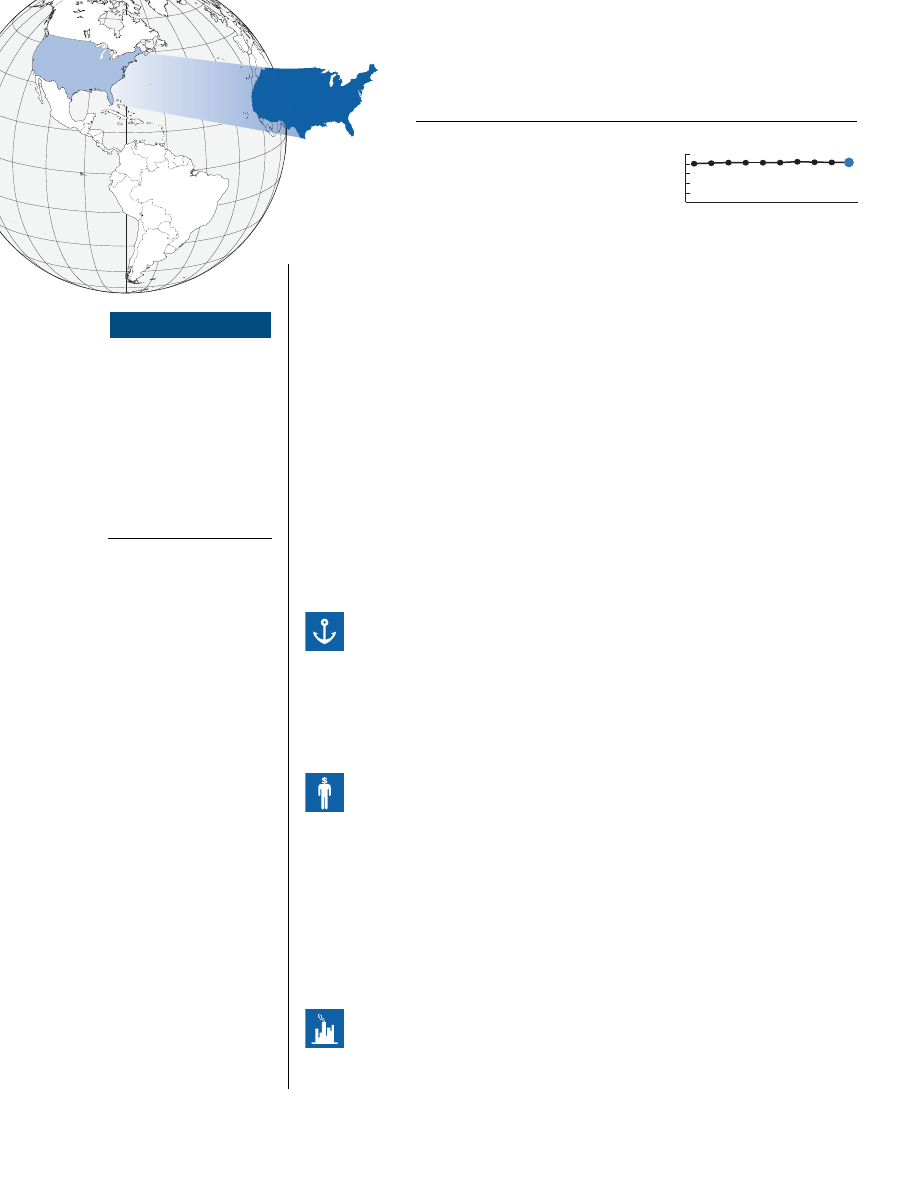
T
he U.S. Constitution provides strong protections for private property, and the vibrancy
and dynamism of the U.S. economy are testimony to these constitutionally protected
economic liberties. In the post–World War II period, the United States generally took a
strong leadership position in expanding global trade through lower tariff barriers. In the
1980s, economic growth reflected deregulation and tax cuts. In the 1990s, a stable monetary
policy and a wave of technological innovation, buttressed by strong protection of intellectu-
al property rights, continued the growth trend. In 2001, that trend was interrupted by a
recession. With the uncertainties of the Iraq war clarified, the prolonged economic weakness
seems to be dissipating in 2003. In addition, the Administration of George W. Bush has taken
a leadership role in both free trade and reducing domestic tax rates. With signed free trade
agreements with both Singapore and Chile, ongoing negotiations with Morocco, Australia,
and the Central American countries, and overtures to other countries throughout the world,
global free trade once again has become a viable possibility. Domestically, the top marginal
tax rates for individuals have been reduced several percentage points, and the partial elim-
ination of double taxation on dividends leaves corporations less reliant on debt financing,
and therefore less vulnerable to economic downturns. Inflation is almost nonexistent, and
interest rates are the lowest in half a century. Overall, the United States remains one of the
world’s freest and most vibrant economies. The United States’ fiscal burden of government
score is 0.1 point better this year. As a result, its overall score is 0.01 point better this year.
TRADE POLICY
Score:
2–Stable
(low level of protectionism)
The World Bank reports that the United States’ weighted average tariff rate in 2001 (the most
recent year for which World Bank data are available) was 1.8 percent. According to the
Economist Intelligence Unit, the government imposes non-tariff barriers, including quotas,
tariff rate import quotas, antidumping provisions, countervailing duties, and licensing
requirements, on a number of goods.
FISCAL BURDEN OF GOVERNMENT
Score—Income Taxation: 3.5–Stable
(high tax rates)
Score—Corporate Taxation: 4.5–Stable
(very high tax rates)
Score—Change in Government Expenditures: 3.5–Better
(low increase)
Final Score:
4–Better
(high cost of government)
The United States’ top federal income tax rate is 35 percent, down from the 39.1 percent
reported in the 2003 Index. (This decrease is not substantial enough to affect the United
States’ income taxation score, however.) The top corporate tax rate is 35 percent.
Government expenditures as a share of GDP increased less in 2002 (0.7 percentage point to
35.6 percent) than they did in 2001 (1.3 percentage points). As a result, the United States’ fis-
cal burden of government score is 0.1 point better this year.
GOVERNMENT INTERVENTION IN THE ECONOMY
Score:
2–Stable
(low level)
Based on data from the U.S. Bureau of Economic Analysis, the government consumed 15.5
percent of GDP in 2002. In 2001, according to the International Monetary Fund, the United
SCORES
Trade Policy
2
Fiscal Burden
4
Government Intervention
2
Monetary Policy
1
Foreign Investment
2
Banking and Finance
1
Wages and Prices
2
Property Rights
1
Regulation
2
Informal Market
1.5
Population: 288,600,000
Total area: 9,629,091 sq. km
GDP: $9.2 trillion
GDP growth rate: 2.4%
GDP per capita: $31,830
Major exports: industrial sup-
plies, consumer goods, auto-
motive goods, food and bev-
erages, travel services, finan-
cial and insurance services,
computer and information
Exports of goods and ser-
vices: $1.08 trillion
Major export trading part-
ners: Canada 23.2%, Mexico
14.1%, Japan 7.4%, UK 4.8%
Major imports: Crude oil,
refined petroleum products,
automobiles, consumer goods,
industrial raw materials, finan-
cial and insurance services
Imports of goods and ser-
vices: $1.6 trillion
Major import trading part-
ners: Canada 18.1%, Mexico
11.6%, China 10.8%, Japan 10.4%
Foreign direct investment
(net): –$83.8 billion
UNITED
STATES
U. S. A.
CANADA
MEXICO
THE BAHAMAS
CUBA
PANAMA
EL SALVADOR
GUATEMALA
BELIZE
HONDURAS
NICARAGUA
COSTA RICA
JAMAICA
HAITI
DOM. REP.
ARGENTINA
BOLIVIA
COLOMBIA
VENEZUELA
PERU
BRAZIL
FRENCH GUIANA
SURINAME
GUYANA
CHILE
ECUADOR
PARAGUAY
URUGUAY
AFRICA
EUROPE
Q U I C K S T U DY
403
2002 Data (in constant 1995 US dollars)
UNITED STATES
Rank: 10
Score: 1.85
Category: Free
1.99 1.94 1.88 1.89 1.89 1.88 1.79 1.84 1.86
5
4
3
2
1
'04
'03
'02
'01
'00
'99
'98
'97
'96
'95
Present & Past Scores
1.85
(Best)
(Worst)

States received 3.11 percent of its total revenues from state-
owned enterprises and government ownership of property.
MONETARY POLICY
Score:
1–Stable
(very low level of inflation)
From 1993 to 2002, the United States’ weighted average annu-
al rate of inflation was 2.05 percent.
CAPITAL FLOWS AND FOREIGN INVESTMENT
Score:
2–Stable
(low barriers)
The United States welcomes foreign investment. Foreign and
domestic enterprises are treated equally under the law; for-
eign investors are not required to register with or seek
approval from the federal government; and there are no local
content requirements or ownership restrictions on most
industries. The government continues to restrict foreign
investment in nuclear energy, maritime and air shipping and
transport, broadcast licenses, and communications. It also
restricts foreign acquisitions that threaten to impair national
security. Restrictions on financial transactions with Cuba and
Cuban nationals, Burma, Iran, Iraq, Libya, Sudan, the
Taliban, specified terrorist groups, and specified drug traf-
fickers are strict and enforced. There are no controls or
requirements on current transfers, access to foreign exchange,
or repatriation of profits. Purchase of real estate is unrestrict-
ed on a national level, although purchase of agricultural land
by foreign nationals or companies with at least 10 percent for-
eign ownership must be reported to the U.S. Department of
Agriculture; some states impose restrictions on purchases of
land by foreign nationals.
BANKING AND FINANCE
Score:
1–Stable
(very low level of restrictions)
Federal and state governments share regulatory responsibili-
ty for banks. In recent years, there has been substantial dereg-
ulation of banking. Reform of the Glass–Steagall Act and the
1956 Bank Holding Company Act in 1999 eliminated barriers
to entry into U.S. financial markets and removed prohibitions
against the purchase of banks by insurance and securities
companies. This has facilitated both the creation of universal
financial services companies and the competitiveness of U.S.
banking, as well as further consolidation of the financial ser-
vices industry, enabling U.S. firms to compete more effective-
ly in global markets. According to the Economist Intelligence
Unit, “The US has the largest, deepest and most sophisticat-
ed capital markets in the world. Access to funds for both for-
eign and domestic investors is excellent.” A troubling devel-
opment during the 1990s was the growing nationalization of
mortgage risk through the growth of government-sponsored
enterprises focused on housing finance. However, the overall
trend in financial services is toward more competition and
continued product innovation. Foreign banking and securi-
ties firms generally compete on an equal footing with domes-
tic firms.
WAGES AND PRICES
Score:
2–Stable
(low level of intervention)
Overall, the market sets wages and prices. According to the
Economist Intelligence Unit, “Price controls do exist for some
regulated monopolies (like utilities and the postal service),
and certain states and localities control residential rents. The
most recent imposition of price restrictions was approved on
May 2nd 2002, when the state legislature of Hawaii approved
price caps on petrol prices, which have historically been
higher than in any other US state.” The federal government
continues to influence prices on some goods and services by
purchasing excess production, closing borders to imports,
and manipulating prices through subsidies to companies like
Amtrak. The government also influences prices of some dairy
products by subsidizing dairy farmers. Under the recently
enacted Farm Security and Rural Investment Act of 2002,
agricultural spending and subsidies will rise by more than 80
percent (from $100 billion to $180 billion) over the next 10
years, with subsidies for corn, soybeans, wheat, rice, and cot-
ton increasing by 70 percent. While these subsidy amounts
are immense, so is the U.S. agricultural sector (and the econ-
omy in general, of which agriculture accounts for only 2 per-
cent), and this reduces the overall impact of agricultural sub-
sidies on prices. The federal government imposes a minimum
wage.
PROPERTY RIGHTS
Score:
1–Stable
(very high level of protection)
The United States does very well in most measures of prop-
erty rights protection, including an independent judiciary, a
sound commercial code and other laws for the resolution of
property disputes between private parties, and the recogni-
tion of foreign arbitration and court rulings. However, the
concerns outlined in the 2003 Index linger. Uncompensated
government expropriations of property remain highly
unlikely, but local governments’ abuse of eminent domain
power with the seizure of private land (with some compensa-
tion) and its transfer to another party for a non-public or
quasi-public use has become more common—despite some
successful legal challenges to that practice. An even more
serious problem is that governments at all levels impose
numerous regulatory and land-use controls that diminish the
value and enjoyment of private property. Examples include
extensive “growth controls”; unreasonable zoning hurdles;
facility permitting regimes; and far-reaching environmental,
wetlands, and habitat restrictions on the use and develop-
ment of real estate. Thus, the protections for private property
are undermined by a vast bureaucracy that has the power to
interfere substantially with many property rights. The level
of protection for property in the United States may eventual-
ly turn on whether the courts place clear limits on bureau-
cratic power or require cost-effective remedies for property
owners whose rights have been affected. In recent years, the
Supreme Court’s performance in such government “takings”
cases has been decidedly mixed. The past year was a disap-
404
2004 Index of Economic Freedom

2004 Index of Economic Freedom
405
pointment, with the Court reversing itself in Brown v. Legal
Foundation of Washington and holding that states may seize
the interest from certain attorney–client trust accounts and
not pay compensation.
REGULATION
Score:
2–Stable
(low level)
Establishing a business is easy. “Through a fairly simple pro-
cedure,” reports the Economist Intelligence Unit, a firm “can
then set up offices, plants or other permanent establishments
under the corporation laws of other states…. Firms may
choose a location on the basis of which state’s laws offer
greater flexibility.” The U.S. labor market is one of the
world’s most flexible. According to the EIU, few federal laws
inhibit investment by either foreign or domestic firms.
Regulations are applied evenly and consistently. However,
many regulations—for example, the Americans with
Disabilities Act, various civil rights regulations, environmen-
tal laws, health and product safety standards, and food and
drug labeling requirements—although well-intentioned, can
be onerous. Electronic commerce is minimally regulated. By
global standards, the level of regulation in the United States
is low.
INFORMAL MARKET
Score:
1.5–Stable
(low level of activity)
Transparency International’s 2002 score for the United States
is 7.7. Therefore, the United States’ informal market score is
1.5 this year.
Wyszukiwarka
Podobne podstrony:
Manchester United
4607, Akademia Morska, Atlantic United Marine
58 Eastern United States
Instrukcja IEF Algorytmy i struktury danych lab2
4508, Akademia Morska, Atlantic United Marine
4204, Akademia Morska, Atlantic United Marine
4709, Akademia Morska, Atlantic United Marine
47401PC, Akademia Morska, Atlantic United Marine
sprawa' zvr United Brands (banany)
4722, Akademia Morska, Atlantic United Marine
excercise1 Many Italians immigrated to the United States and?nada
History of the United States' War on Drugs
Mafia in the United States text
5105, Akademia Morska, Atlantic United Marine
4209B, Akademia Morska, Atlantic United Marine
What The United States?n Learn From Japan
59 Eastern United States
więcej podobnych podstron